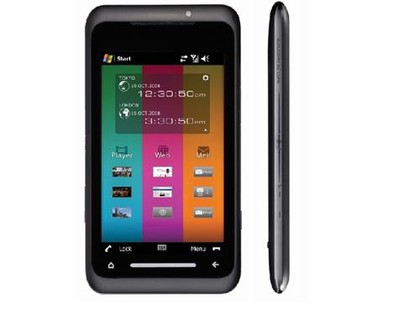TechRadar Verdict
A good concept ruined by too many mistakes - there's only so much the Windows Mobile 6.5 upgrade can fix.
Pros
- +
Large touchscreen
- +
Pocket friendly
- +
Good organiser
- +
Novel design
Cons
- -
Poor OS
- -
Slow to re-orientate screen
- -
Underpowered internet browser
- -
Complicated menus
- -
Video quality not as expected
Why you can trust TechRadar
Toshiba is back with the TG01 - a phone that it hopes will propel it to the forefront of the smartphone market, jostling the iPhone 3GS and HTC Hero out the way in the process.
It plans to do this by creating the largest, thinnest and fastest mobile in the industry, but will that be enough to create an instant hit for Tosh? Let's take a look through the phone's inner workings with the Toshiba TG01 review.
The main things that Toshiba is keen to point out are the fact it has the fastest processor around, in the shape of the Qualcomm Snapdragon 1 GHz processor, and it's also among the thinnest at under a centimetre. It's running Windows Mobile 6.1, and all the signs point to a free upgrade when version 6.5 hits in a few months' time.
But the first thing to note about this phone is the screen. Let's not beat around the bush here; it's massive at 4.1 inches. What's more curious is that Toshiba decided not to stop there – there's up to two centimetres more border around that screen to extend the phone to a frankly insane 129 x 70 x 9.9 mm chassis size.
In the hand, these dimensions just feel odd. It's a phone that exceeds anything you'll have felt before as the screen is the largest seen on a 3G phone. Where the screen extended to the edges of the phone, it could have been a lot more ergonomic, but as it stands, it just feels... very strange.
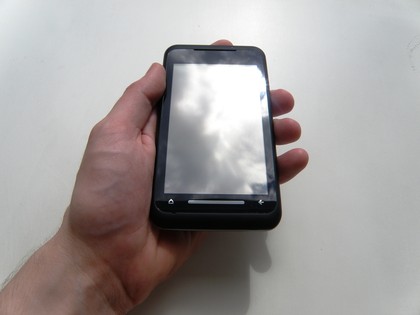
But thankfully, the gigantic dimensions are somewhat balanced by the light 129g weight and 9.9mm depth, meaning it feels a lot lighter than it looks. It's also (bizarrely) one of the most pocketable phones, as long as you have deep pockets, so perhaps the chassis size isn't as much to worry about.
The button layout on the sides of the phone is a little weird, with the power and volume controls down the left hand edge and the camera and micro-USB socket (covered by a hard-to-close flap) on the right.
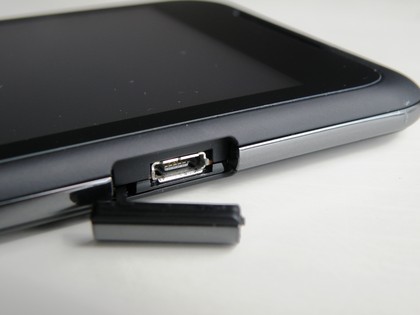
The front of the device, right at the bottom, features three touch sensitive offerings – the home and back buttons, and the touch sensitive bar that used for dragging up the Free Pad, in a similar way to the Palm Pre and its gesture zone, and for zooming in and out of web pages.
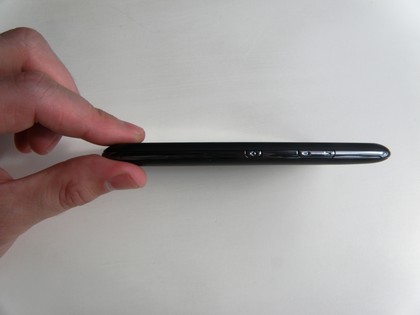
The call and terminate buttons are placed on the touchscreen itself, as well as the softkey options too, and are slightly to small to press easily on the go, although if you stop and make you're hitting the right place it's no big deal.
The back of the TG01, featuring the 3.2MP camera without flash at the top, is made of matte plastic, which dare we say it, feels a little flimsy and doesn't quite fits as snugly to the main chassis as we would have liked, with quite a bit of give.
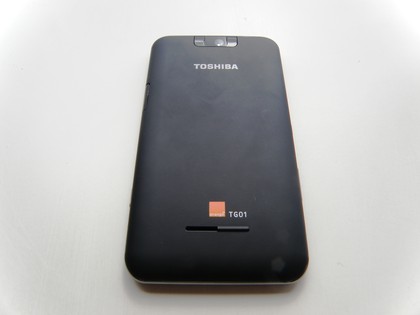
Overall, the lightness and size of the phone are the first things you notice when picking it up. The buttons are nicely flush to the chassis, and are easy-ish to find and press while still maintaining the minimalist design. It's not going to be a phone to every customer's taste, but at least Tosh, having come up with this design, has implemented it well.
Turning the phone on takes quite some time, especially the first time you switch it on. Apart from displaying a Toshiba logo, the TG01 appears to have frozen, and most people who buy it will probably go through a brief period of worry that they have broken it.
The screen, a WVGA resistive effort, is only reasonably responsive, although viewing anything on the screen is clear and pin sharp. Swiping through menus or tapping on a certain icon is a bit of a hit and miss experience however, and certainly not up there in the iPhone 3GS or Palm Pre leagues.
At the top of the phone is an LED designed to let you know when the phone is low on battery (red), a call or text has arrived (blue) and when the phone is in sleep mode (green).
The latter is thoroughly annoying, winking away at you when the phone screen is off, and is rather reminiscent of a Simpsons scene when Homer invents an alarm that goes off in a cacophony every five minutes to let people know everything's alright.
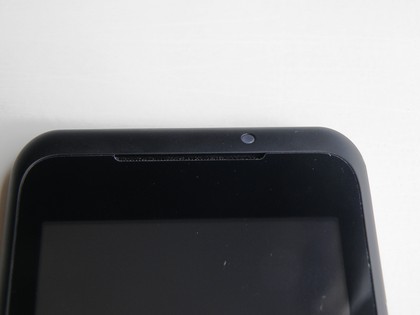
Thankfully, this can be turned off, where other phones (such as early N-Series Nokias) refused to let you do this, meaning you wanted to break them more and more as the contract wore on.
The power button allows the phone to be turned off (obviously) but also re-activates the screen when turned off and sleep mode is activated (which we can recognise thanks to the green flashing light).
However, for some inexplicable reason the length of time needed to press the power button to exit sleep mode can vary from less than a second to two or three, with no reason for the delay, which is a very annoying situation when you constantly want to check your phone.

We were a little bit confused by the processing speed and the way Toshiba has demonstrated it in the phone. When flipping the phone on its side, there's a second or two's wait until it re-orientates itself, and then the whole phone is available in landscape mode, which is pretty awesome.
But the question is: how often would you use a phone exclusively in landscape unless you were to buy a dock (and we're not sure if they're available) and connect up a keyboard, using it as a mini PC? It's a well-executed touch though, and in fairness other screens twist round a lot quicker within phone, although nowhere near as fast as others (especially those from the Android range.)
In the box
Toshiba has provided a whole host of different bits and pieces in the box for the TG01, even including two CDs (Syncing software and User Guide).
There's a microUSB charger and 3.5mm headphone adaptor, some instantly upgradeable headphones, and connection lead for the PC and a microUSB to USB adaptor.
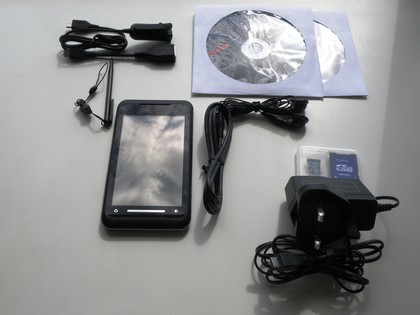
Toshiba, despite claims it won't be needed, has still popped a stylus in the box, and to help boost the TG01 claims of being a media phone, the UK version also gets an 8GB microSD card as well as a normal SD card converter to play said media on other devices too.
Current page: Toshiba TG01: Overview, look and feel
Next Page Toshiba TG01: Interface
Gareth has been part of the consumer technology world in a career spanning three decades. He started life as a staff writer on the fledgling TechRadar, and has grew with the site (primarily as phones, tablets and wearables editor) until becoming Global Editor in Chief in 2018. Gareth has written over 4,000 articles for TechRadar, has contributed expert insight to a number of other publications, chaired panels on zeitgeist technologies, presented at the Gadget Show Live as well as representing the brand on TV and radio for multiple channels including Sky, BBC, ITV and Al-Jazeera. Passionate about fitness, he can bore anyone rigid about stress management, sleep tracking, heart rate variance as well as bemoaning something about the latest iPhone, Galaxy or OLED TV.
